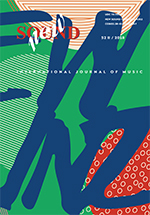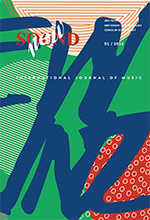Issue No. 36
Composer Speaks
Ksenija Stevanović – VOCALISE AND THE EXPERIENCE OF PROSOPOPOEIA OF ANJA ĐORĐEVIĆ
Download: ser / eng
Core Issue
Dragana Jeremić Molnar – LIED: FROM HAUSMUSIK TO FILM
On the example of Franz Schubert's Winterreise
Abstract: The inspiration to write this article came from a personal experience. A few years ago, I bought a successful visualization of Franz Schubert’s Lieder cycle Winterreise, issued on DVD. This affected me in two ways: first, I began to develop a strong interest in this kind of approach, to a basically non-dramatic work (and continued my search for similar DVD products) and secondly, as a result of watching Schubert’s Lieder, I almost stopped enjoying Winterreise in the usual way – by only listening to it. This acceptance of a newly invented, different mode of Lieder presentation made me wonder about the reasons that inspire various artists to enrich Winterreise with new layers and to supplement it with a scenic dimension. I was in the position to analyze the achievements of such artists (in the third part of this article) only after I had examined the attitude towards the performance of Lieder in Schubert’s time (in the first part) and his own contribution to the disclosure of Winterreise’s dramatic potentialities (in the second part).
Keywords: Franz Schubert, Lied, Winterreise, performing practice, Gesamtkunstwerk.
Download: ser / eng
Ana Kotevska – CONCERT METAMORPHOSES OF IN/VISIBLE AND IN/AUDIBLE
Abstract: Classical music repertoire and artistic music concerts have been, until recently, left apart from the audiovisual, multimedia creative space, reserved mostly for contemporary sound. In recent years, visualisation of the concert ritual on new grounds is being recognized as the spirit of time. First and foremost, the point is in the search for a visual-arts counterpart for the most popular works of the artistic repertoire from musicians’ standpoint: the road leads from a recognizable sound to the new moving images, conceived for the occasion, with the mutual effort at establishing the dialogue between parallel worlds of expression, with preservation of the autonomous identity of each artistic discipline and the synchronization of traditional performing apparatus and state-of-the-art technology. Using the examples of two author projects – polyptychs which inspired this item, new emerging concert forms and their repercussion are presented: Pictures Reframed by Norwegian pianist Leif Ove Andsnes and South African video artist Robin Rhode, and Equi Voci by Belgian composer and video artist Thierry De Mey, realized in collaboration with the conductor Michel Tabachnik and Brussels Philharmonics.
Keywords: correspondences, concert ritual, audiovisual concert, metamorphoses, new technologies, interpreter, interactive apparatus.
Download: ser / eng
Mirjana Veselinović-Hofman – DRAMA WITH MUSIC DIE GLÜCKLICHE HAND BY ARNOLD SCHÖNBERG AS A MULTIMEDIA PROJECT
Abstract: Drama with music Die Glückliche Hand [The Lucky Hand] by Arnold Schönberg is examined in this study from the perspective of the composer’s concept of specifically combining elements of different arts. The investigation is aimed at the interpretation of Schönberg’s actual artistic realization of this concept, and, consequently, the type of the breakthrough in the traditional opera genre which was thus effectuated. It concerns a complex lyric stage conception which hints at multimedia forms of modern artistic expression.
Keywords: Arnold Schönberg, Die Glückliche Hand [The Lucky Hand], Gesamtkunstwerk, multimedia project, mixed-medium, polymedium, intermedium.
Download: ser / eng
Miško Šuvaković – DEMATERIALIZATION OF THE STAGE
(Epistemology of New Media in Performance Arts and Music)
Abstract: One of the fundamental, philosophical ontological questions discussed in this text is whether the technological system and practice or the system and practice of digital technology can be considered a medium (media system and material provider of practice) of theatre art, music and performance art as “live arts”. Bearing this question in mind, the concept of media is redefined in several ways: as an instrumental and/or communicative extension of the human body, i.e. object, mechanical, electromechanical, electronic, digital or network prosthesis; as an agent or communicator, first of all, between human and other bodies, i.e. between machines and biological organisms; as a medium through which communication goes on between a source and a receiver; and as an instrument or technology of mass and individual one-way and interactive communication, that is, an affectation interaction that turns into a situation of “apparatus”.
Keywords: Affectation, Music, New Media, Performance Arts, Metamedium, Postmedium, Sound Art.
Download: ser / eng
Jelena Novak – MONSTERIZATION OF SINGING: POLITICS OF VOCAL EXISTENCE
Abstract: In this paper I theorize embodiment of the voice in Steve Reich/Beryl Korot’s video documentary opera Three Tales paying specific attention to the novel techniques of “production of the voice” that Steve Reich introduces. Emphasis is on Act 3 Dolly where a number of questions regarding cloning, defining human, and artificial intelligence have been raised. Voice appears beyond corporeality. I use two theoretical texts while performing analysis of Three Tales: Bojana Kunst’s “Restaging the Monstrous” about the status and function of monstrous body and its political and theatrical productivity based on the cessation within the human, and constant production of the norm of what human is and is not and Mladen Dolar’s considerations on politics and linguistics of the voice. I read those texts through Three Tales and analyze Three Tales through these texts aiming to introduce the monstrous voice concept. Monsterization of voice gives Three Tales status of operatic manifest whose subject is im/possibility of controlling the power of technology upon the human body and society. Opera appears as the place of social critique.
Keywords: monstrous voice, post/opera, singing body, politics of the voice.
Download: ser / eng
Ana Hofman – SOCIALIST STAGE: POLITICS OF PLACE IN MUSICAL PERFORMANCE
Abstract: The article addresses the visual and spatial aspects of musical performance not just as makers of already structured discourses, but elements which have a strong formative role in constructing new conceptualizations of the musical performance itself. Staging, which was introduced as a part of the new socialist cultural politics, is investigated as a spatial process, by which the power relations are performed and new discourses of musicking are reproduced. By focusing on the politics of staging and concepts of publicity and rituality, the article discusses the ways local musical practices started to be conceptualized as specific kinds of cultural artefacts, ‘local tradition’ or ‘historical past.’ It further investigates how these new conceptualizations synchronized/contested various discourses of musical performance, simultaneously negotiating among various actors in the local environment – performers, local organizers, professionals, policy makers and community.
Keywords: staging, musical performance, socialism, politics, publicity, rituality.
Download: ser / eng
Falk Hübner – ENTERING THE STAGE – MUSICIANS AS PERFORMERS IN CONTEMPORARY MUSIC THEATRE
Abstract: The article seeks to explore the role of musicians as theatrical performers in theatre, and how this role has been developed from the 20th century up to the present. The profession of musicians in theatre has been greatly expanded since the days of Stravinsky’s L’histoire du soldat through the Instrumental Theatre of Kagel and Schnebel in the 1960’s up to contemporary multimedia performances and the influence of digital and interactive technology. Opposed to these expansive concepts this essay introduces reductionist approaches as alternative ways of working with musicians in the theatre.
Keywords: music theatre, instrumental theatre, musicians as performers, reductive approach, task-based performance, theatricalisation of music, Heiner Goebbels, Mauricio Kagel, Igor Stravinsky.
Download: ser / eng
Ana Gadzinski – APPROPRIATED MUSIC – AN ALTERED SYSTEM OF RELATIONSHIPS BETWEEN MUSIC AND IMAGE
Abstract: It is noticeable that the relationship between music and image has been considerably altered since a few decades ago. But what is the nature of it? If we persistently stick to analyzing the scores, we are prone to miss it, and if we assign the innovations in film music to technological developments alone, the final assumption will not be the one of a musical nature, or a musicological one, respectively. This article is looking into alternative approaches that have emerged within the fields of sound theory and the aesthetics of popular music in the last decades. Aside from this, the modern art concepts require the implementation of the specialized vocabulary. The aim is to gain a closer look at characteristics of both ‘sides’ and suggest a new place for film music, preferably beyond the common commerce versus art frontier.
Keywords: sound film, musical aesthetics, musical material/parameters, cultural values, representation, recording.
Download: ser / eng
New Works
Vesna Mikić – MILICA PARANOSIĆ: POSTCARDS
Abstract: Razglednice [Postcards], a piece by Milica Paranosić, has been commisioned by Hungarian Embassy in Belgrade on the occasion of the birth centennial of Miklós Radnóti, a Hungarian poet of Jewish origin who spent his last days in Nazi working camp in the Serbian city of Bor. In four movements, the piece conveys four Radnóti's “postcards” in Hungarian (narrator) and Serbian (soloists and choir), and in the manner of “dramatic oratorio” that transcends the conventional generic boundaries, as well as those between text and music, traditional and classical music, body and language…
Keywords: vocal-instrumental music, Serbian music, Milica Paranosić, Miklós Radnóti, Razglednice.
Download: ser / eng
Branka Radović – TWO FACES OF OPERA.
Premieres of new Serbian operas: Hasanaginica by Rastislav Kambasković and Mandragola by Ivan Jevtić
Abstract: Two composers of different generations, stylistic and authorial poetics, Rastislav Kambasković and Ivan Jevtić attended the premiere performances of their operas in the same month of the year. Until now, neither of them has dealt with the opera genre: both operas are firstlings in their respective opuses, but the works differ in genre, style, type and character. Hasanaginica is a large-scale opera for a big apparatus, a psychological music drama written for eight soloists, a mixed choir and large orchestra. Mandragola is a comic opera without a choir, written for seven soloists. The former was performed on the stage of the National Theatre, the latter on the stage of the private theatre, the Madlenianum. It is interesting that both were commissioned: one by the national house and its institutions, and the other by a single person, Madlena Zepter, the owner of the Madlenianum Opera and Theatre.
Keywords: Rastislav Kambasković, Ivan Jevtić, opera, libretto, drama, music language, main characters.
Download: ser / eng
Research and Tradition
Liz Mellish & Nick Green – NEW OPPORTUNITIES FOR ROMANIAN FOLK ENSEMBLE PERFORMERS: HOW THE AVAILABILITY OF MODERN TECHNOLOGIES HAS CONTRIBUTED TO 21ST CENTURY FOLK PERFORMANCE STRATEGIES IN TIMIŞOARA
Abstract: This paper will focus on contemporary folk music and dance practices in the Romanian region of Banat. It considers how folk performers living in the city of Timişoara are taking advantage of new opportunities for folk performance provided by modern media and technologies, thus enabling them to increase their visibility and produce performances which fit into contemporary situations. It will conclude that the utilisation of these technologies has enabled folk performers to simultaneously engage with notions of modernity and nostalgia in the eyes of their audiences and maintain a prominent profile in regional Bănăţeni identity.
Keywords: Romania, Banat, music, dance, song, media, technology, visibility, modernity, nostalgia.
Download: ser / eng
Festivals and Symposia
Ivana Petković – COPY&PASTE – MINE, YOURS, OURS UNDER DISCUSSION.
The 23rd International Student Symposium of DVSM e.V.
Institute for Musicology, University of Vienna, 9–12 October 2009
Download: ser / eng
Mirjana Zakić – THE SECOND ALL-RUSSIAN CONGRESS OF FOLKLORISTS.
National Republican Centre for Russian Folklore,
Moscow, 1–5 February 2010
Download: ser / eng
Dragana Stojanović-Novičić – LIGETI’S LE GRAND MACABRE IN LONDON
Download: ser / eng
Reviews
Miško Šuvaković – ETHNOMUSICOLOGY BETWEEN ANTHROPOLOGY AND SEMIOLOGY
Download: ser / eng
Ana Kotevska – PAVLE STEFANOVIĆ: PUTEVIMA SIMFONIJE [THE ROADS OF THE SYMPHONY]. Belgrade, RTS, Opredmećeni zvuk [Reified Sound] Series, 2009, 271
Download: ser / eng
Biljana Milanović – STANA ĐURIĆ-KLAJN AND SERBIAN MUSICOLOGY.
On the occasion of the hundredth anniversary of the birth of Stana Đurić-Klajn (1908-1986), Serbian Musicological Society, Belgrade 2010
Download: ser / eng


